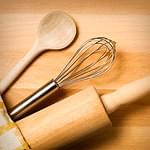
Yield:Yields about 1 lb., enough for one
I can’t argue with Joyce Goldstein when she says fresh homemade egg pasta is the best choice for making her classiclasagne。我还没有找到一个现成的面食,垫ches the rich flavor and light, ethereal texture of good homemade pasta. Making your own pasta takes a bit of time—the dough is fast to make, but rolling it into thin sheets takes about 45 minutes (though it goes faster with practice). You’ll need a food processor, apasta rolling machine, and lots of kitchen towels and counter space for laying out your pasta sheets.
亚搏手机版官方
- 10 oz. (2-1/4 cups) unbleached all-purpose flour; more for kneading and rolling
- 1 tsp. kosher salt
- 1 Tbs. extra-virgin olive oil
- 4 large eggs, lightly beaten
Nutritional Information
- Nutritional Sample Size per 2 oz.
- Calories (kcal) : 160
- Fat Calories (kcal): 35
- Fat (g): 4
- Saturated Fat (g): 1
- Polyunsaturated Fat (g): 0
- Monounsaturated Fat (g): 2
- Cholesterol (mg): 95
- Sodium (mg): 160
- 碳水化合物(克):23
- Fiber (g): 1
- Protein (g): 6
Preparation
Make the dough:
- Put the flour and salt in a food processor fitted with the plastic dough blade. Pulse three or four times to blend. With the processor running, pour the olive oil down the feed tube and then slowly pour in the eggs. Continue processing until the dough clumps around the blade, about 10 seconds. It will be a little wet and sticky.
- Transfer the dough to a lightly floured surface and knead it by hand until it’s smooth, about 2 minutes. If it seems very sticky and too wet, add a little more flour and continue kneading for 1 more minute. Shape the dough into a ball and dust it lightly with flour. Wrap tightly with plastic and let rest at room temperature for 30 minutes (or refrigerate or freeze).
Roll out the dough:
- Unwrap the dough ball and cut it into four equal pieces. (Let refrigerated dough come to room temperature; defrost frozen dough in the fridge and let it come to room temperature.) Take one piece and leave the other three covered in plastic. Flatten the piece of dough with the palm of your hand until it’s about 1/2 inch thick and shape it as close to a rectangle as possible.
- Dust the flattened piece lightly with flour and pass it through the machine rollers at the widest setting

- Fold it in three, like a letter. Dust the dough with more flour and pass it through again, still folded, starting from a short side. Repeat this step two or three times, folding the dough in three each time and dusting with flour as needed

- Then without folding the dough, repeatedly pass it through the machine rollers, reducing the space between the rollers after each pass (dust the dough with flour on both sides before each pass).

- When the dough becomes so long that it’s difficult to manage, trim the uneven ends and cut the dough in half crosswise to make two more-manageable lengths of dough. Continue passing each piece through progressively narrower settings. If you’re making pasta sheets for lasagne, stop on the second- or third-narrowest setting; the pasta should be slightly translucent but not so thin that it will tear. For other types of pasta, like fettuccine, linguine or ravioli, continue to the thinnest setting.

- As you finish rolling each sheet, set it on a lightly floured kitchen cloth and cover with another cloth to prevent the dough from drying out. Or, if not using within an hour or so, layer the sheets between parchment, plastic wrap, or waxed paper to keep them from sticking together and refrigerate or freeze.
Make Ahead Tips
The pasta dough can be refrigerated for 24 hours or frozen for up to 1 month, either before or after rolling into sheets.
Tip
Because each machine is different, it’s difficult to say at what exact setting to stop. For lasagne, you want the pasta to be no thicker than 1/16 inch, but not so thin it will tear. It’s usually best to stop a setting or two before the final (thinnest) setting—#5 or #6 on a KitchenAid attachment, #7 or #8 on an Atlas machine.
Ingredient Spotlight
-
 FEATURED
FEATUREDChinese Black Rice
Reviews
Rate or Review
Reviews (3 reviews)
-
 deirdre07| 01/26/2022
deirdre07| 01/26/2022This recipe really works! My nine-year-old made flawless pappardelle! and it was delicious too.
-
 YKDonna| 06/07/2013
YKDonna| 06/07/2013This is the one! I have made this recipe about 10 times now and it is always perfect. Thank you Fine Cooking.
-
 fguidry| 12/16/2012
fguidry| 12/16/2012The lasagna I've made with these noodles have been the most praised dishes I've ever served. The simple food processor mixing and the clear procedure for rolling the dough are bonus features.
What We're Cooking Now
-
Collection
17 Ideas for Sunday Grilling
-
Collection
Fresh Corn Fast
-
Collection
Summer Gazpacho
![]() Collection
CollectionThe Best Culinary Mashups
![]() Collection
CollectionChopped Salads, Summer's Perfect Meal
![]() Collection
CollectionOur 12 Best Summer Watermelon Recipes
![]() Collection
CollectionA Dozen Desserts Inspired By Country Fairs




















Write a Review